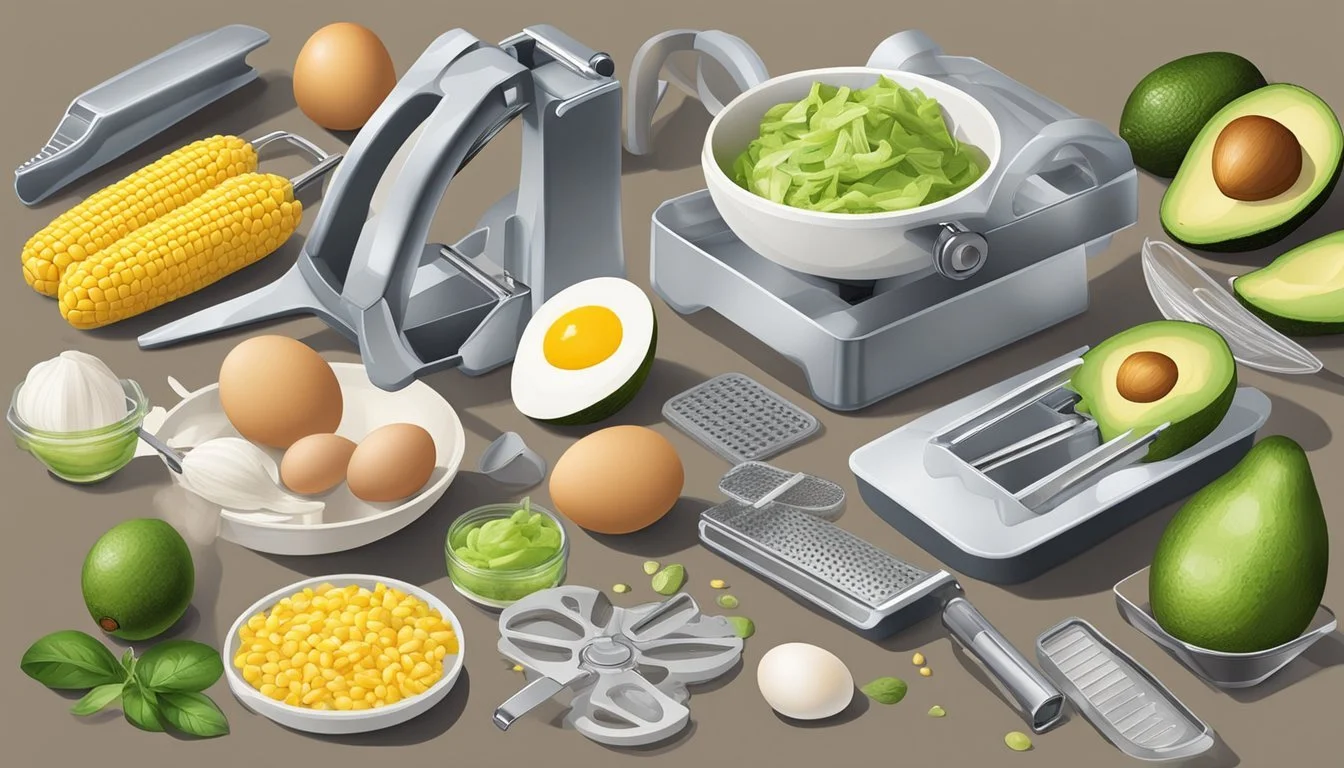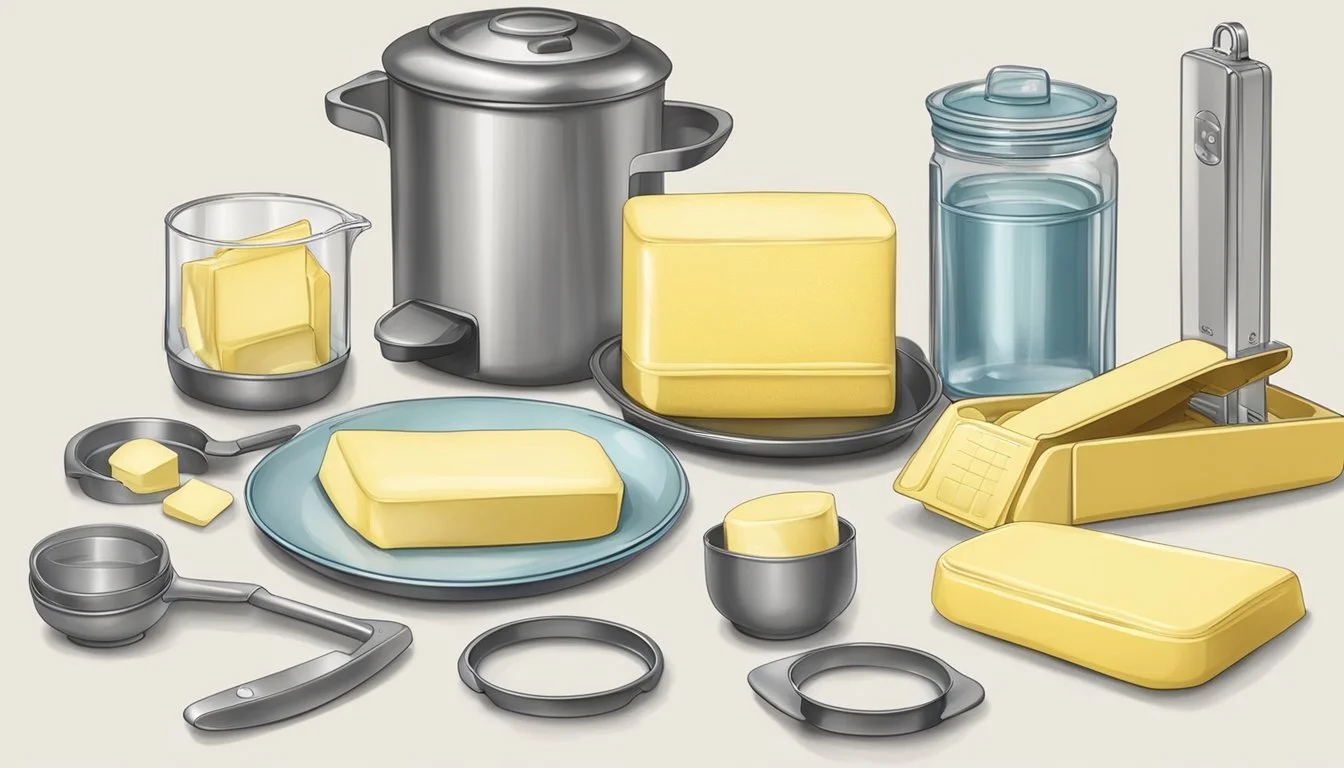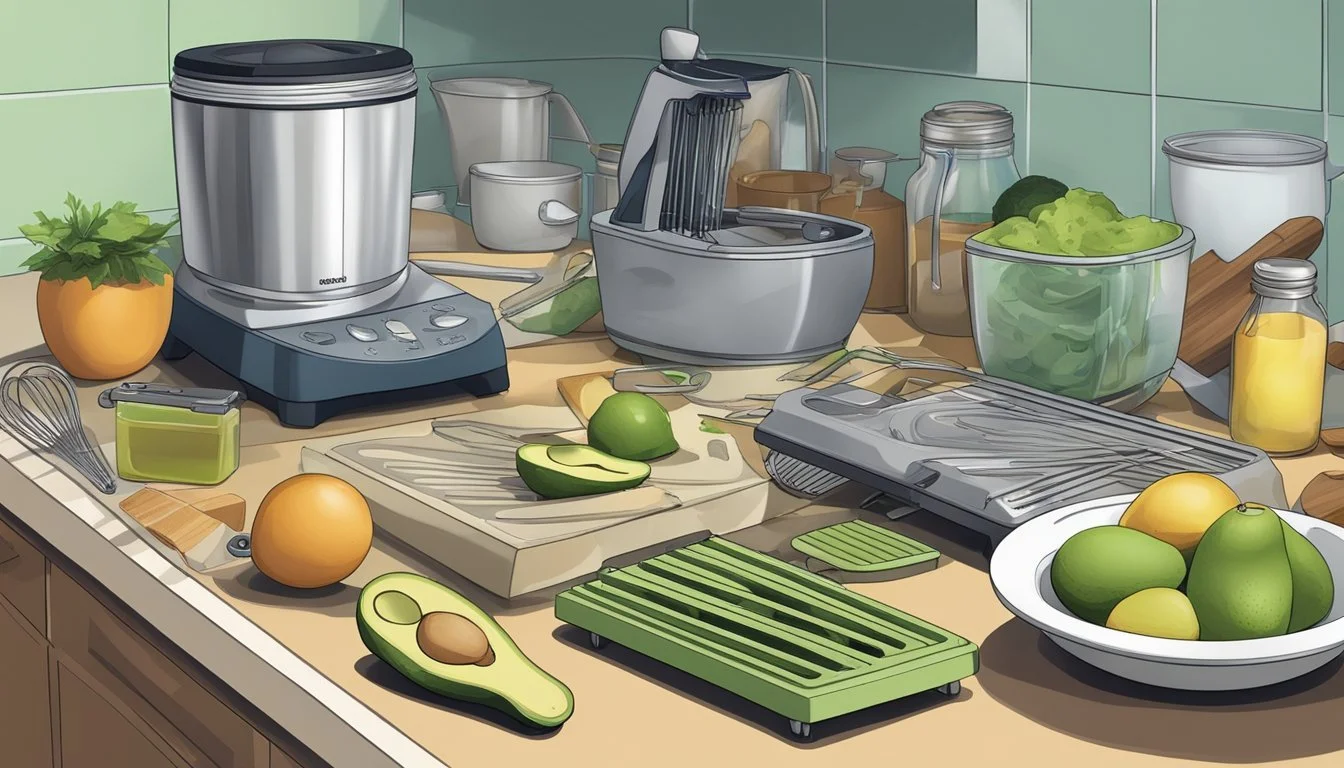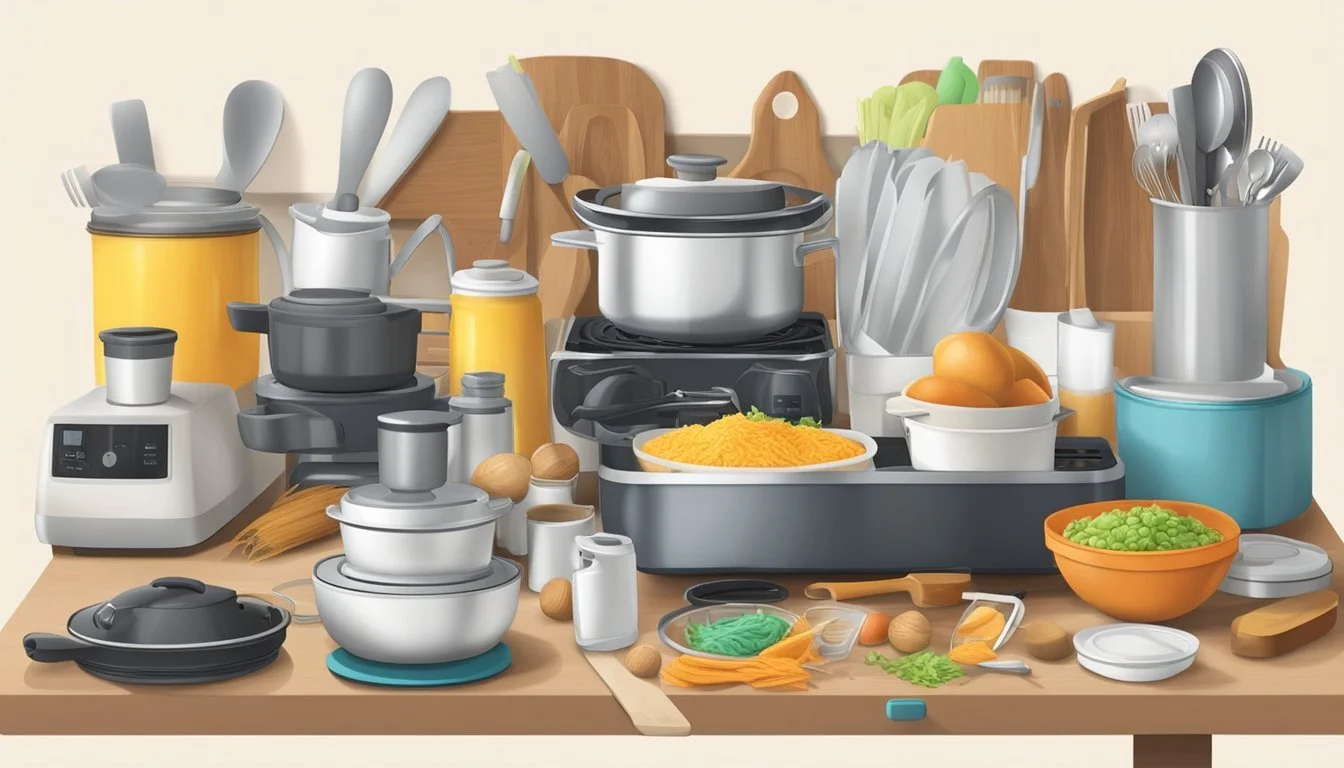10 Useless Kitchen Gadgets That Waste Your Money and Space in 2024
In the pursuit of culinary perfection, gadgets flooding the market promise to simplify cooking and add flair to the kitchen. While some tools genuinely enhance the efficiency and enjoyment of meal preparation, others fall short of their claims or offer solutions to non-existent problems.
Identifying which gadgets provide real value and which clutter your drawers can save time, money, and frustration. This article will shine a light on ten commonly praised kitchen gadgets that may not live up to the hype. Through a critical look, readers can better decide what belongs in their kitchen and what to leave on the store shelf.
1) Banana Slicer
The banana slicer has gained notoriety for its limited utility. This simple, plastic device is designed to slice bananas quickly. Shaped to fit the curve of the banana, it cuts multiple slices in one motion.
Despite its intended convenience, a regular knife can accomplish the task just as efficiently. Bananas are soft fruits, requiring minimal effort to slice. Even a butterknife is effective for this purpose, making the slicer redundant.
Critics argue that the banana slicer exemplifies unnecessary consumerism. It's often viewed as a novelty rather than a must-have kitchen tool. The space it occupies in a drawer could be better utilized for more versatile utensils.
2) Butter Spreader with Butter Retainer
The Butter Spreader with Butter Retainer aims to simplify the process of spreading butter on various foods.
While the idea seems practical, it often falls short in everyday use. Users find that it works well on items like corn on the cob but struggles with bread or toast.
The design typically includes a compartment to hold butter and a mechanism to dispense it. Despite this, the spreader's performance can be inconsistent, sometimes making a mess rather than providing a neat solution.
For many, traditional butter knives are more effective. They offer greater control and versatility, negating the need for a specialized gadget that may sit unused in a kitchen drawer.
3) Avocado Slicer
The avocado slicer is often marketed as a must-have kitchen gadget. Many believe it can simplify the process of preparing avocados. It typically features a pitting tool, a knife-like edge, and a slicing grid.
Despite its intentions, the avocado slicer frequently falls short of expectations. For many users, the tool's effectiveness is underwhelming, and it can even become an unnecessary addition to the kitchen drawer.
First, the pitting tool may struggle with avocados of varying sizes. A simple spoon can often accomplish the task more reliably. Additionally, the slicing grid might not achieve a clean cut, leading to a frustrating experience.
Another point of contention is safety. The tool's knife-like edge can pose a risk, especially if not used with caution. Regular kitchen knives, when handled carefully, can be safer and more versatile.
Lastly, the avocado slicer tends to take up space without offering significant value. With limited functionality, it often ends up unused after a few attempts, proving more cumbersome than practical.
4) Electric Egg Cooker
An electric egg cooker may seem like a handy kitchen gadget at first glance. It claims to simplify the process of boiling eggs, but it often falls short in practicality and efficiency.
This device occupies valuable counter space, which can be a drawback in small kitchens. Most people already have saucepans or pots that can boil multiple eggs simultaneously with little effort.
Electric egg cookers also tend to add unnecessary complexity. Users must measure water levels precisely, set timers, and monitor the device to avoid overcooking. Traditional boiling methods are straightforward and allow more flexibility.
The electric egg cooker’s cleaning process can be cumbersome. It's usually easier to clean a pot than the small components of an egg cooker. Thus, it introduces more hassle than convenience.
5) Hot Dog Toaster
A hot dog toaster is a kitchen gadget designed to toast hot dogs and buns simultaneously. It has slots to hold both the hot dogs and buns, aiming to provide a quick and easy way to prepare this simple meal.
Despite its specific function, this gadget is quite limited. Traditional cooking methods, like grilling or stove-top preparation, offer more versatility. Regular toasters or ovens can easily handle the bun toasting, and they serve multiple purposes beyond hot dogs.
Hot dog toasters also take up valuable counter space. This can be a concern for those with limited kitchen area. Many people find that they rarely use this gadget, making it an impractical addition to their kitchen.
6) Pizza Scissors
Pizza Scissors are designed to cut and serve pizza slices in one motion. They combine a pair of scissors with a flat spatula on one side, theoretically easing the pizza-cutting process. The idea is to eliminate the need for a wheel-style pizza cutter and a separate lifter.
Despite this, they add unnecessary complexity to a task that is easily handled by simpler tools. Traditional pizza cutters or even a knife serve the same purpose without the added bulk. The flat, wide blade of Pizza Scissors can also be cumbersome.
Another issue is storage. Pizza Scissors are larger and take up more space compared to a standard pizza cutter. Their awkward shape makes them difficult to fit into typical kitchen drawers. Many users find them to be more of a novelty than a practical tool.
Cleaning can be another downside. The multi-part design often has more nooks and crannies where cheese and sauce can get stuck, making them trickier to clean thoroughly. This defeats any time-saving benefit they might purport to offer.
Considering the simplicity and effectiveness of existing pizza-cutting tools, Pizza Scissors often end up being an unnecessary addition to the kitchen.
7) Taco Holder Stand
The taco holder stand aims to make taco assembling and serving more convenient. These stands come in various materials, including stainless steel, plastic, and wood. They typically feature slots to hold multiple tacos upright, preventing spillage of ingredients.
While useful in theory, many find taco holders to be unnecessary. Tacos can simply be placed on a plate, eliminating the need for this specific utensil.
Some taco holders are oven-safe, providing the added benefit of warming tacos directly in the holder. However, this added feature often does not justify the price or storage space they require.
Plastic taco holders lack durability and are not suitable for use in ovens or grills, limiting their functionality. Stainless steel or wooden holders are more durable but tend to be more expensive.
Many kitchens already feel cluttered, and adding a taco holder stand to the mix may not make sense for those who only occasionally prepare tacos. For frequent taco enthusiasts, the convenience may be appreciated, but for others, it may just be another item collecting dust.
Ultimately, the taco holder stand is a gadget that many can do without. Its practicality varies greatly depending on individual needs and cooking habits. Usefulness aside, it remains a niche gadget in the kitchen tool spectrum.
8) Rotato Express
The Rotato Express is an electric peeler designed to make peeling fruits and vegetables quick and easy. Users can simply place the item on the peeler, press a button, and the Rotato Express will do the rest. This device claims to peel various items in seconds, from potatoes to apples and tomatoes.
While the Rotato Express sounds appealing, its practicality is questionable. Traditional peelers are compact, cost-effective, and require no electricity. In contrast, the Rotato Express needs a power source and takes up more kitchen space.
Another point of contention is the maintenance. The device has multiple parts, including replaceable blades that need to be purchased separately. This adds to the long-term cost and inconvenience compared to simple manual peelers.
Safety is a consideration, too. Though the Rotato Express is marketed as ultra-safe, any device with blades presents risks. Manual peelers, when used correctly, also offer safety and control without needing extra storage or electricity.
The Rotato Express might impress visitors with its automation. Still, for many, it could be an unnecessary addition to the kitchen, adding complexity where simplicity often works best.
9) Pasta Measuring Tool
A pasta measuring tool is designed to help cooks portion out the right amount of pasta per person. These tools usually consist of a flat piece with various holes, each labeled with servings.
While the concept seems useful, in practice, it often falls short. Portion sizes can be subjective, varying widely from person to person based on appetite and dietary needs.
Most people already estimate pasta portions fairly accurately using common kitchen items. For instance, a fistful of spaghetti is a common measure many find reliable.
Moreover, bulkier pasta types like penne and farfalle do not fit well through the predefined holes. This limits the tool's versatility, making it impractical for all pasta varieties.
Additionally, these measuring tools can take up unnecessary space in kitchen drawers. Given their limited functionality, most find them redundant.
In a typical kitchen, a scale or even simple visual estimation can easily replace a pasta measuring tool.
10) Pineapple Corer
The pineapple corer is marketed as a convenient tool to make slicing pineapples easier. This gadget boasts the ability to peel, core, and slice pineapples swiftly.
While it sounds handy, the reality is not always so seamless. Pineapples vary in size, and a one-size-fits-all corer might not work perfectly for all pineapples. The result can be uneven slices or missed cores.
Additionally, using a corer can waste a significant amount of pineapple flesh. Traditional methods with a knife might take a bit more effort but often yield better results with less waste.
Storage can also be a concern. The pineapple corer is a single-purpose tool, taking up valuable drawer or counter space for a task that can easily be done with a knife.
Cleaning a pineapple corer is another drawback. Pineapple juice can be quite sticky, and the tool’s intricate design can make thorough cleaning challenging.
For those who eat pineapple occasionally, it might be more practical to use a knife. This approach requires fewer steps and less cleanup.
In essence, the pineapple corer might not be the most efficient or essential tool in everyone’s kitchen, especially when considering its limitations.
Why These Gadgets Exist
Understanding why these seemingly useless kitchen gadgets find their way into popular use involves examining consumer trends and the marketing strategies employed by companies.
Consumer Trends
One significant driver behind the existence of these gadgets is the ongoing quest for convenience.
Consumers are constantly seeking ways to simplify daily tasks, prompting manufacturers to develop tools that promise time-saving solutions.
Trends also indicate a fascination with novelty. Consumers are drawn to unique and quirky gadgets, even if their practical use is questionable.
Additionally, social media and online reviews can greatly influence purchasing decisions. Gadgets that gain traction on platforms like Instagram or TikTok often see increased sales, regardless of utility.
Gift-giving is another factor. These gadgets often serve as fun and whimsical presents for holidays or special occasions, further fueling demand.
Marketing Strategies
Effective marketing campaigns play a crucial role in the popularity of these gadgets.
Companies often emphasize the unique features and supposed benefits of their products through eye-catching advertisements. Infomercials and online videos frequently demonstrate how these gadgets can make kitchen tasks easier, even if the reality is different.
Limited-time offers and exclusive deals create a sense of urgency, compelling consumers to make impulsive purchases.
Collaborations with influencers and celebrity endorsements enhance the appeal, leveraging the trust and dedicated following these personalities command.
Additionally, packaging and branding make the gadgets appear innovative and essential, enticing buyers who may not necessarily need them.
The Impact of Useless Gadgets
Useless kitchen gadgets often result in both environmental impacts from material waste and financial losses for consumers. These aspects can have significant long-term effects.
Environmental Concerns
The production and disposal of useless kitchen gadgets contribute to environmental degradation. Many of these gadgets are made from plastic and non-recyclable materials, which means they end up in landfills, contributing to pollution and the growing problem of plastic waste.
Furthermore, the manufacturing process of these gadgets consumes natural resources and energy, producing emissions that impact air quality. When broken or obsolete, these gadgets often cannot be repaired or recycled, perpetuating a cycle of waste.
Key Points:
Non-recyclable materials increase landfill waste.
Production consumes resources and energy.
Breaking gadgets contribute to ongoing waste proliferation.
Financial Waste
Consumers often spend money on gadgets that end up unused, representing a significant financial drain. Initial costs may seem insignificant, but they add up over time. Gadgets like the Butter Applicator or Plastic Egg Mold are examples where the promise of convenience hardly justifies the expense.
Additionally, these purchases can lead to buyer’s remorse, where individuals regret buying items that provide little practical value. The financial resources spent on these gadgets could be better allocated toward more useful and enduring kitchen tools.
Key Points:
Initial purchase costs can accumulate.
Gadgets frequently underperform or go unused.
Money spent on ineffective tools leads to financial inefficiency.
What Makes a Gadget Useless?
Useless kitchen gadgets often suffer from a lack of practicality and redundancy. These issues can affect both their functionality and their value in a kitchen setup.
Lack of Practicality
A gadget is considered impractical if it does not perform its intended function effectively. Tools that are difficult to clean, require complicated assembly, or are frustratingly slow fall into this category. For example, gadgets like a butter applicator may seem helpful, but if they fail to apply butter evenly or are hard to clean, they become impractical.
Another sign of impracticality is if the gadget is very specialized but rarely used. Items like egg molds to shape eggs into fun designs might see limited use, making their practicality questionable.
Redundancy
Redundancy occurs when a gadget duplicates the function of another, often simpler, tool that already exists in the kitchen. An example is a plastic egg mold, which can be effectively replaced by a simple knife for slicing eggs.
Gadgets that are marketed to perform a single, specific task that can be done easily with common kitchen tools, such as forks or knives, often fall into this category. For instance, a corn butterer may seem unique, but a standard butter knife can accomplish the same task, rendering the specialized gadget redundant.












